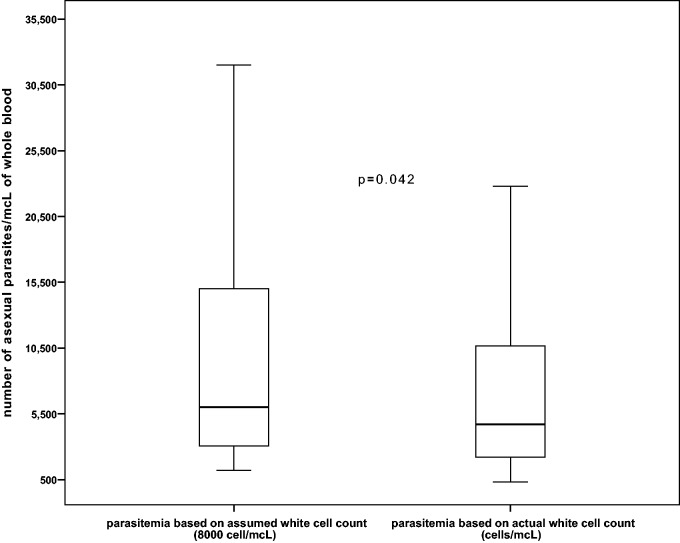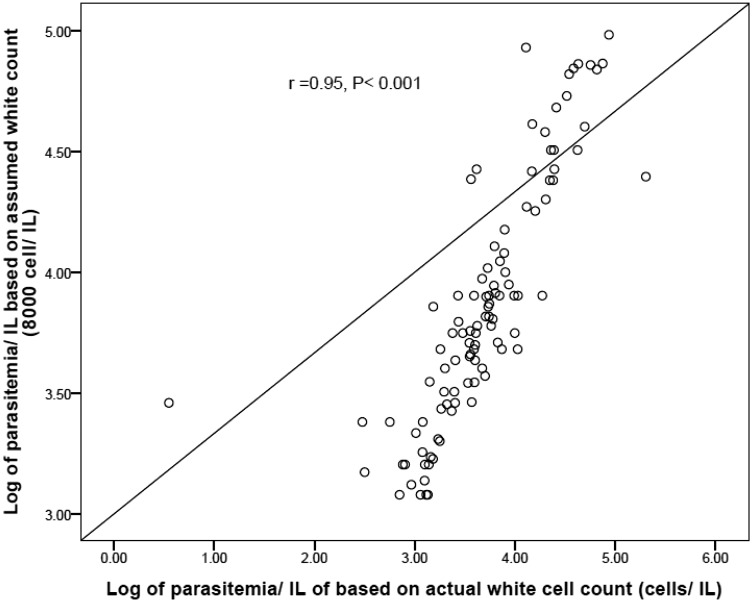Abstract
Background: Estimating malaria parasite count is needed for estimating the severity of the disease and during the follow-up.
Objective: This study was conducted to determine the malaria parasite density among children using actual white blood cell (WBC) and the assumed WBC counts (8.0 × 109/l).
Methods: A cross-sectional study was conducted at New Halfa Hospital, Sudan. WBC count and count of asexual malaria parasite were performed on blood films.
Results: One hundred and three children were enrolled. The mean (SD) WBCs was 6.2 (2.9) cells × 109/l. The geometric mean (SD) of the parasite count using the assumed WBCs (8.0 × 109/l cells/μl) was significantly higher than that estimated using the actual WBC count [7345.76 (31 038.56) vs. 5965 (28 061.57) rings/μl, p = 0.042].
Conclusion: Malaria parasitemia based on assumed (8.0 × 109/) WBCs is higher than parasitemia based on actual WBCs.
Keywords: malaria, parasite, white cell, children, Sudan
INTRODUCTION
Malaria should be confirmed by a parasitological test [1]. Microscopy is an important tool for parasite quantification / malaria parasite density, which is performed by counting parasites within a given number of microscopic fields, against counted white blood cells (WBCs) within the same fields [1, 2]. Owing to the scant resources in malaria-endemic countries for quantification of patients’ WBCs, an assumed WBC count of 8.0 × 109/l is used to quantify malaria parasite densities [3]. However, WBCs vary greatly from individual to individual, are age dependent and are unreliable during febrile episodes [4]. With the advent of automated machines, researchers are evaluating the assumed WBCs method vs. the actual count of the WBCs [5–8]. This study was conducted to compare the malaria parasite density among children using actual WBC and the assumed WBC counts (8.0 × 109/l).
METHODS
A cross-sectional study was conducted at New Halfa Hospital, Sudan, during the period from August to October 2013. After signing an informed consent form, febrile children (temperature ≥ 37.5°C) were examined and data sheet was used to collect demographic information.
Blood films for malaria and hematological analysis were performed as described in our previous work [8]. In summary, thick blood slides were 10% Giemsa stained and examined under the × 100 oil immersion objective lens of a light microscope. The asexual parasites density was counted against 200 WBCs. Parasite densities (parasite/μl of whole blood) were then calculated as follows:
(Number of parasites counted/WBC counted) × WBC count/µl of participant.
The complete blood count, including white cells, was analyzed using Sysmex KX-21NTM automated hematology analyzer according to the manufacturer’s instruction manual.
Ethics
This study received ethical clearance from Board of the Faculty of Medicine, University of Khartoum, Sudan.
Statistics
Data were entered in computer using SPSS for Windows. Mann–Whitney U-test was used to compare the geometric means of the parasite count using the actual count and the assumed (8.0 × 109/l) WBCs for each patient. Nonparametric correlation was used to detect the relation between continuous variables.
RESULTS
Of the 103 children enrolled, 53.4% were males; major characteristics and blood indices are illustrated in Table 1. The mean (SD) WBC count was 6.2 (2.9) cells/μl, with a range of 1.2–18.7 and a median of 6.1 cells × 109/l.
Table 1.
Age and laboratory characteristics of children with malaria participating in the study
| Variable | Mean (SD) [range] |
|---|---|
| Age in years | 7.71 (5.06) [0.25–15] |
| Hemoglobin concentrationg/dl | 9.87 (2.6) [3.6–15.8] |
| White cell count 109/l | 6.2 (2.9) [9.8–18.7] |
| Platelet count 109/l | 154.44 (74.07) [26–400] |
The geometric mean (SD) of the parasite count using the assumed WBCs (8.0 × 109/l) was significantly higher than that estimated using the actual WBC count [7345.76 (31 038.56) vs. 5965 (28 061.57) rings/µl, p = 0.042]; figure 1. The two parasitemias were positively correlated (r = 0.95, p < 0.001); figure 2. There was no significant difference in the mean (SD) WBCs count [6.4 (3.6) vs. 5.9 (2.2) cell × 109/l, p = 0.558] and parasitemia (using both assumed and actual WBCs) in children when correlated by the age; figure 3.
Fig. 1.
Comparison of parasitemia in children using assumed and actual WBC counts of 8000 cell/μl.
Fig. 2.
Correlations between log of parasitemias using actual and assumed white cell count of 8000 cell/μl.
Fig. 3.
(A, B) Comparison between log parasitemia counted on assumed (8000 cell/μl) and actual white cell count in children correlated by age.
DISCUSSION
The main finding in this study was that parasite density calculated using the actual WBC count was significantly lower than that calculated using the assumed WBCs. This is in agreement with our previous results [8] and findings of Adu-Gyasi et al. [6] and Jeremiah and Uko [9].
CONCLUSION
Malaria parasitemia based on assumed (8.0 × 109/l) WBCs is higher than parasitemia based on actual WBCs.
References
- 1.WHO. Diagnosis of malaria. Guidelines for the treatment of malaria. 3rd edn. Geneva: World Health Organization, 2015. http://apps.who.int/iris/bitstream/10665/162441/1/9789241549127_eng.pdf?ua=1
- 2.Ochola LB, Vounatsou P, Smith T, et al. The reliability of diagnostic techniques in the diagnosis and management of malaria in the absence of a gold standard. Lancet Infect Dis 2006;6:582–8. [DOI] [PubMed] [Google Scholar]
- 3.WHO. Basic malaria microscopy. Geneva: World Health Organization, 2010. http://whqlibdoc.who.int/publications/2010/9789241547826_eng.pdf
- 4.De S, Williams GJ, Hayen A, et al. Republished: value of white cell count in predicting serious bacterial infection in febrile children under 5 years of age. Postgrad Med J 2015;91:493–9. [DOI] [PubMed] [Google Scholar]
- 5.Olliaro P, Djimdé A, Karema C, et al. Standardized versus actual white cell counts in estimating thick film parasitaemia in African children under five. Trop Med Int Health 2011;16:551–4. [DOI] [PubMed] [Google Scholar]
- 6.Adu-Gyasi D, Asante KP, Newton S, et al. Malaria parasite density estimated with white blood cells count reference value agrees with density estimated with absolute in children less than 5 years in central Ghana. Malar Res Treat 2015;2015:923674. [DOI] [PMC free article] [PubMed] [Google Scholar]
- 7.Alves-Junior ER, Gomes LT, Assis-Oliveira FB, et al. Quantification of parasite density in 200 microscopic fields underestimates the parasitemia level in malaria patients. Trop Biomed 2014;31:387–91. [PubMed] [Google Scholar]
- 8.Haggaz AD, Elbashir LM, Adam GK, et al. Estimating malaria parasite density among pregnant women at central Sudan using actual and assumed white blood cell count. Malar J 2014;13:6. [DOI] [PMC free article] [PubMed] [Google Scholar]
- 9.Jeremiah ZA, Uko EK. Comparative analysis of malaria parasite density using actual and assumed white blood cell counts. Ann Trp Paediatr 2007;27:75–9. [DOI] [PubMed] [Google Scholar]





